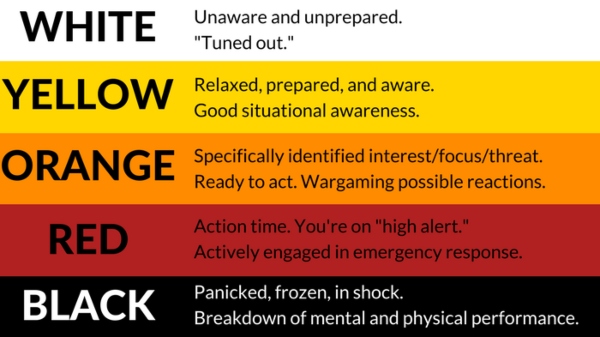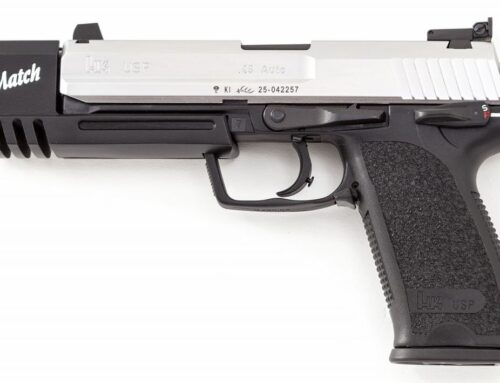Situational Awareness and Risk Levels
As society has progressed, the number of crimes, accidents, and other mishaps that happen every day has increased. Situational awareness and knowing the risk levels have become more important now than ever before. In addition to being a critical component of concealed carry, situational awareness can help individuals stay safe in various situations, such as traveling to unfamiliar places, walking alone at night, or attending crowded events.
In this article, we will explore the levels of situational awareness and how understanding them can improve decision-making and performance in high-pressure situations.
Risk Levels of Situational Awareness
There are levels of situational awareness, and depending on who you talk to, they’ll call them different things, but they’re all similar. Each level requires increasing your attention and focus.
Jeff Cooper, a US Marine, is known as the person who developed the “Modern Technique” of handgun shooting. He devised a color-coding system to describe the levels of awareness.

Level 1 White: Unaware
This is the lowest level of awareness, meaning you are entirely oblivious to your surroundings. You may be distracted by your phone, lost in thought, or just not paying attention. This is the level you do not want to be in out in public because you are unaware of what’s happening around you and not paying attention. In this state, you are an easy target for anyone looking to take advantage of you.
Level 2 Yellow: Relaxed
This level is where you want to be most of the time. In this state, you are aware of your surroundings but also relaxed and calm. You can still enjoy your day and go about your business, but you are paying attention to the people and places around you. This level of awareness is critical because it allows you to spot potential threats before they become dangerous. This means being aware of your environment, the people around you, and any potential dangers that could arise.
Level 3 Orange: Comprehending
At this risk level, you not only perceive potential threats, but you also understand the nature and significance of those threats. This means understanding what the threat is, how it could affect you, and what actions you can take to mitigate the risk. You expect potential threats and mentally and physically prepare for what might happen next. This means having a plan in place to respond appropriately. You are focused but not panicked in this state. Panic is what you want to avoid, and with situational awareness and a plan, you can prevent it.
Level 4 Red: Action
This is the highest level of awareness, meaning you are taking action to protect yourself or others. In this state, you have decided to act and do whatever it takes to neutralize the threat or get to safety. This could mean drawing your firearm, using your self-defense training, or simply running away. Whatever action you take, staying focused and in control is crucial.
Level 5: Frozen
This is a level Cooper didn’t list in his levels, but it is worth mentioning because it is the worst possible thing you can do. Frozen is just what it implies. Your flight-or-fight instinct has failed, and you are stuck like a deer looking into the headlights of an oncoming vehicle.
Training and Experience
Training and experience are critical factors in developing and maintaining situational awareness. Proper training can help individuals develop the necessary skills and knowledge to perceive, interpret, and respond when things go wrong. Experience can also help individuals develop a mental model of the situation, which allows them to anticipate future events and make more accurate predictions about the situation. Therefore, it is essential to provide adequate training and opportunities for practice and experience to enhance situational awareness.
Remember, the key to the four levels of awareness is to stay in Level 2 Yellow as much as possible. By being aware of your surroundings and staying relaxed, you can avoid dangerous situations before they arise. However, if you find yourself in a threatening situation, you must quickly move up to Level 3 or 4 to protect yourself.
Jeff Cooper’s four risk levels of awareness are vital for anyone who carries a firearm or wants to stay safe in today’s world. By understanding these levels and practicing them in your daily life, you can increase your chances of avoiding dangerous situations and staying safe. Stay alert, stay focused, and stay safe!
ABOUT THE AUTHOR:

Brian Armstrong grew up in a small farm town in rural Indiana and learned to shoot before he learned to drive. His career began as a firefighter and medic in Ft Wayne, IN. Throughout the years, he has owned multiple businesses, from construction to technology. His life has come full circle, and he is back to his emergency services roots, teaching emergency first aid and firearms courses.
Brian believes that the best way to learn “HOW” to do something is to first answer “WHY” you do something. He is an average guy with views like yours and is now sharing the knowledge gained from teaching, learning from others, and researching the topics you don’t have time to explore. Follow him at @LetsTalkDGU








